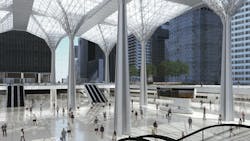The Midwest Regional Rail Plan was released Oct. 13 by the Federal Railroad Administration (FRA).
The plan lays out a vision for a network of high-speed trains that would transform travel across the Midwest. It also makes a strong case for fast, frequent trains that are coordinated and well-integrated into a network. While speed gets most of the spotlight when people talk about trains, frequency and coordination are key to leveraging the full power of a rail network. The plan also points out the urgency of regional cooperation and big-picture planning.
The plan envisions a network that consists of of four “pillar corridors” radiating out from Chicago, with endpoints in Minneapolis-St. Paul, St. Louis, Indianapolis and Detroit. These corridors are the system’s backbone and would make connections much faster and easier between many cities throughout the Midwest.
That’s because the “pillar corridors” would be integrated with transit systems and regional lines that connect mid-sized and major cities—like Indianapolis and Cincinnati, and Kansas City and St. Louis. There would be 24 trains per day on the “pillar” lines and 16 trains per day on the regional lines—an increase over current service levels on U.S. passenger trains.
Incorporating these different lines into a single vision and coordinating them—as the Midwest Regional Rail Plan envisions—gives travelers lots of new options.
The report notes, for example, that there are 189 connections between city pairs if the corridors in the plan are considered as standalone entities, independent of the others. But in a network model—i.e., a model in which travelers can transfer easily between two corridors—the city-pair connections increase to nearly 1,100.
As a result, projected ridership increases to 17 million annual trips by 2055—versus 12 million in the standalone model—and annual revenues increase 59 percent over the standalone model
The power of the phased network approach
The Chicago to Minneapolis-St. Paul route—with intermediate stops in Milwaukee and Madison—is the foundation of the plan’s strategy. As the authors observe, “Chicago remains the core driver of intercity ridership throughout the network, accounting for nearly 30 percent of all trips in 2055. Minneapolis-St. Paul is the second largest market, with over 11 percent of trips originating or ending there.”
The line would change the calculus of providing frequent service from Milwaukee to St. Louis and from Indianapolis to Minneapolis, which would help justify the investments of these lines as part of an integrated network.
A line between Chicago and Indianapolis line could incentivize extending the service on to Louisville and Nashville. The population of greater Nashville, which is currently a little under two million people, is projected to rise over the next several decades.
Fast, frequent service between Nashville, Indianapolis and Chicago would not only affect travel between those cities. It would also incentivize investments in connecting corridors.
As the high Speed Rail Alliance noted recently, this is how a national network could develop in the U.S. over the coming decades: The Chicago to Minneapolis-St. Paul line could incentivize an upgraded line from Chicago to Indianapolis, which could incentivize lines to Nashville and Atlanta. At the same time, high-speed lines are currently being planned from Atlanta to Charlotte and Atlanta to Dallas.
If and when these elements are in place, much of the Midwest, Southeast and East Coast will be connected by a network of passenger trains.
Plan, plan, plan
As the report notes, “If funding for regional rail development becomes available, the Midwest states will have to act immediately.”
Chicago’s Union Station is an excellent example of how local, high-impact projects can have implications well beyond Illinois—and thus demand regional, big-picture thinking.
Union Station was the fourth busiest rail station in the U.S. in 2019, serving more than 3.3 million passengers, according to the High Speed Rail Alliance. But the kind of network the Midwest Regional Rail Plan envisions will require much more from the facility. The alliance has argued for bringing Union Station into the 21st century with renovations that vastly increase its capacity to handle more travelers and more trains.
The value of the Midwest Regional Rail Plan is that it offers a broad vision of what a regional network of fast, frequent trains could look like, says the High Speed Rail Alliance. In making the case for why the states must work together to get this done—and why the fast, frequent trains and a phased network approach are crucial to success—it marks a huge step forward for the Midwest and the nation.



